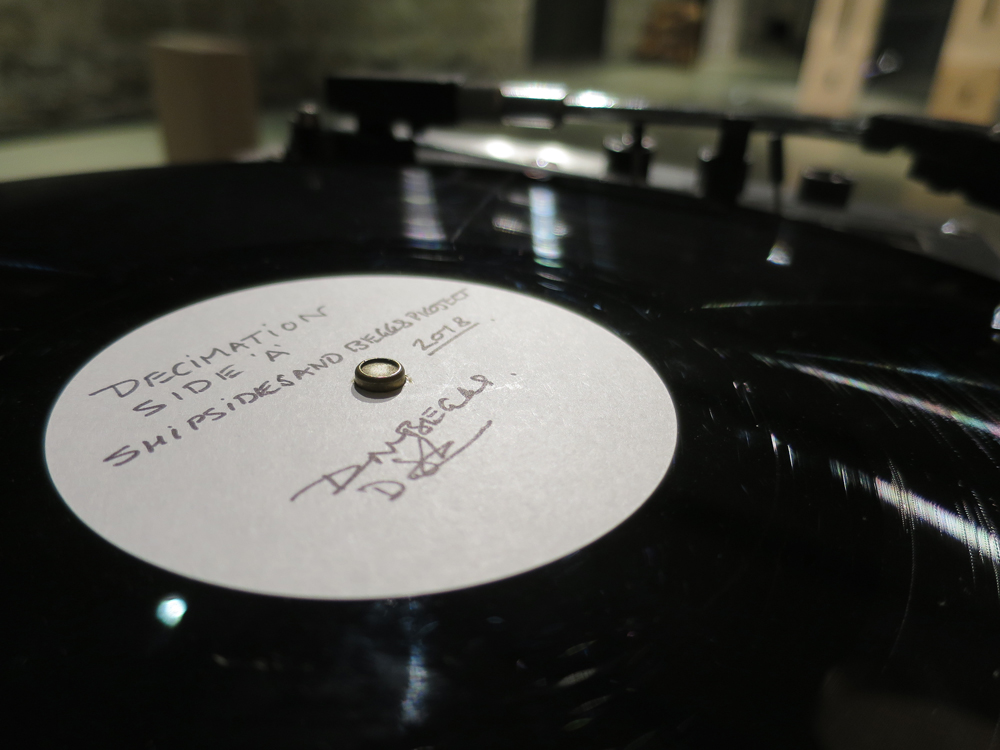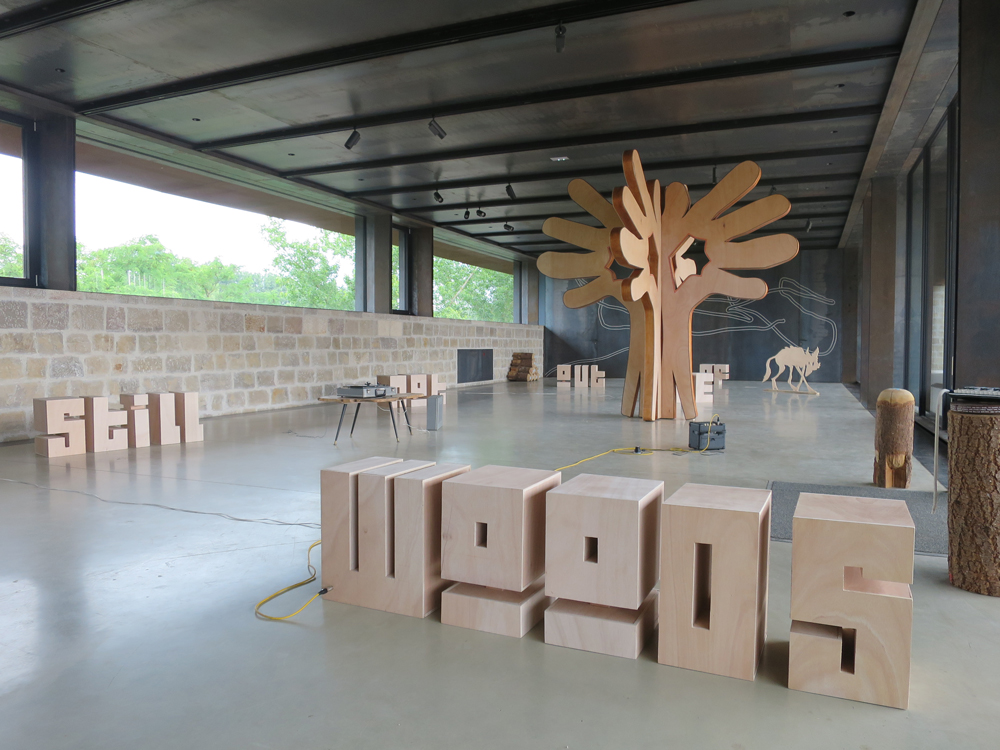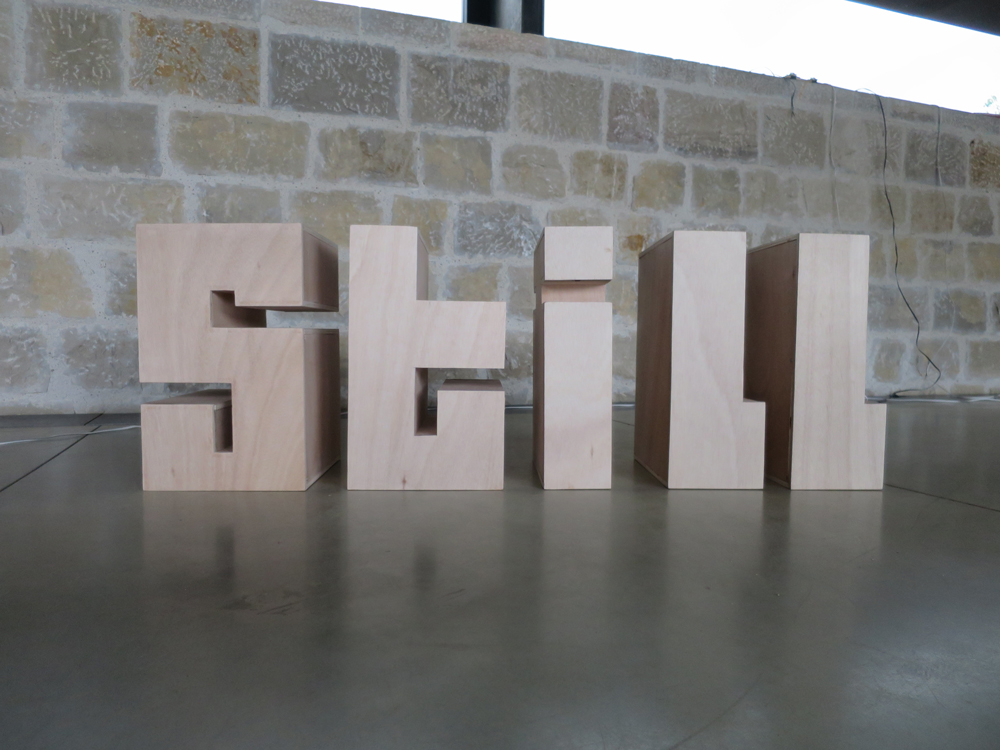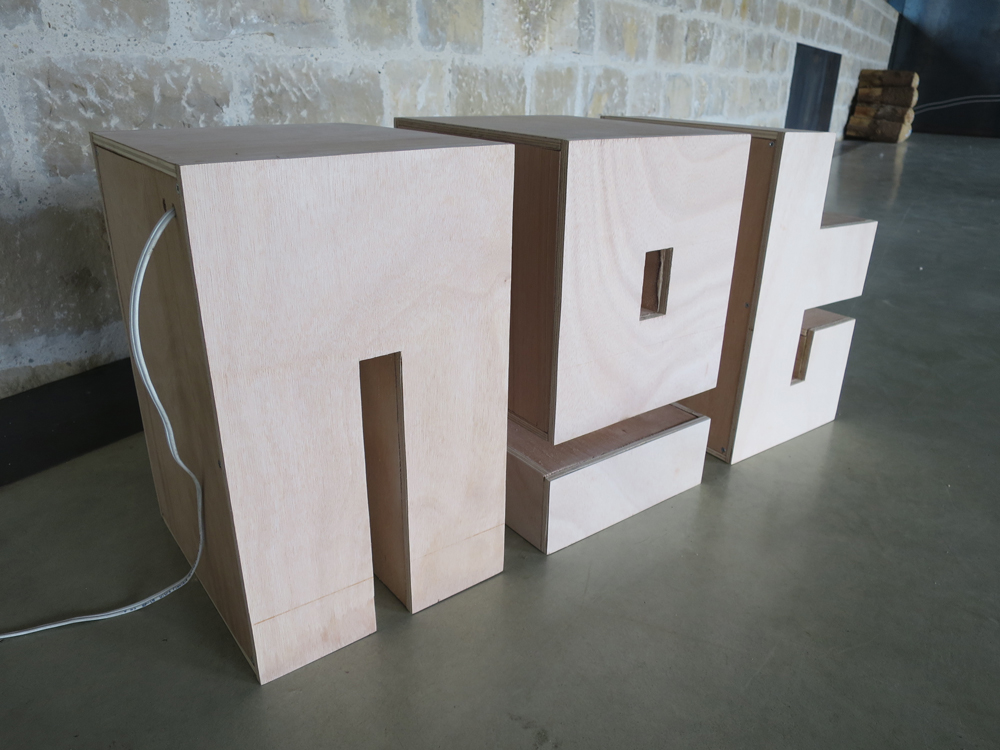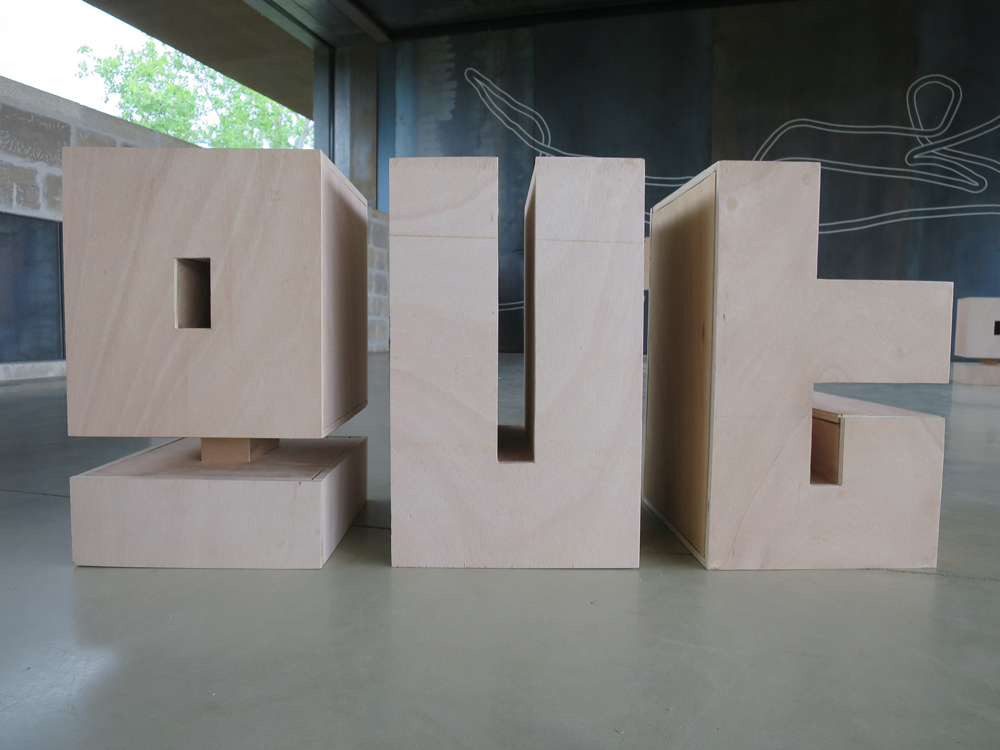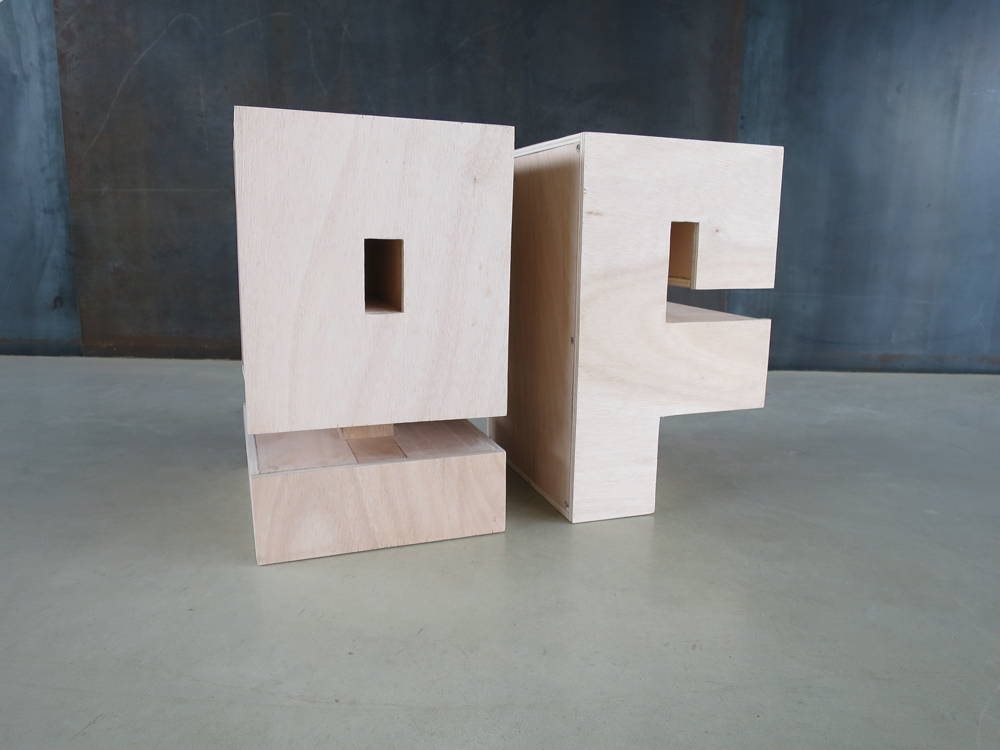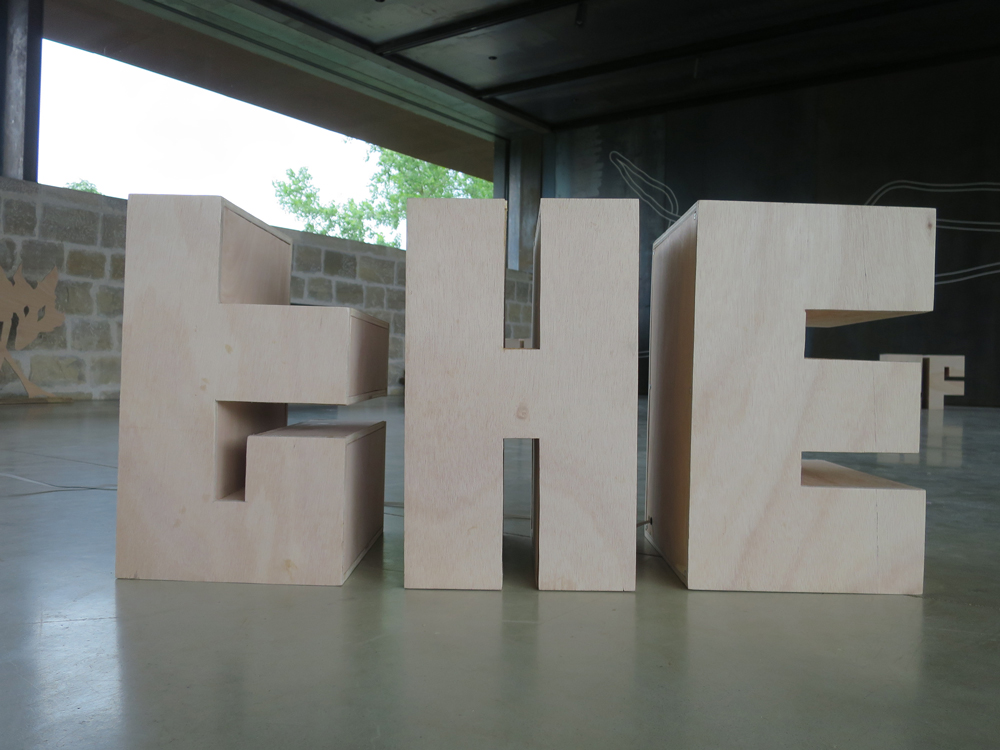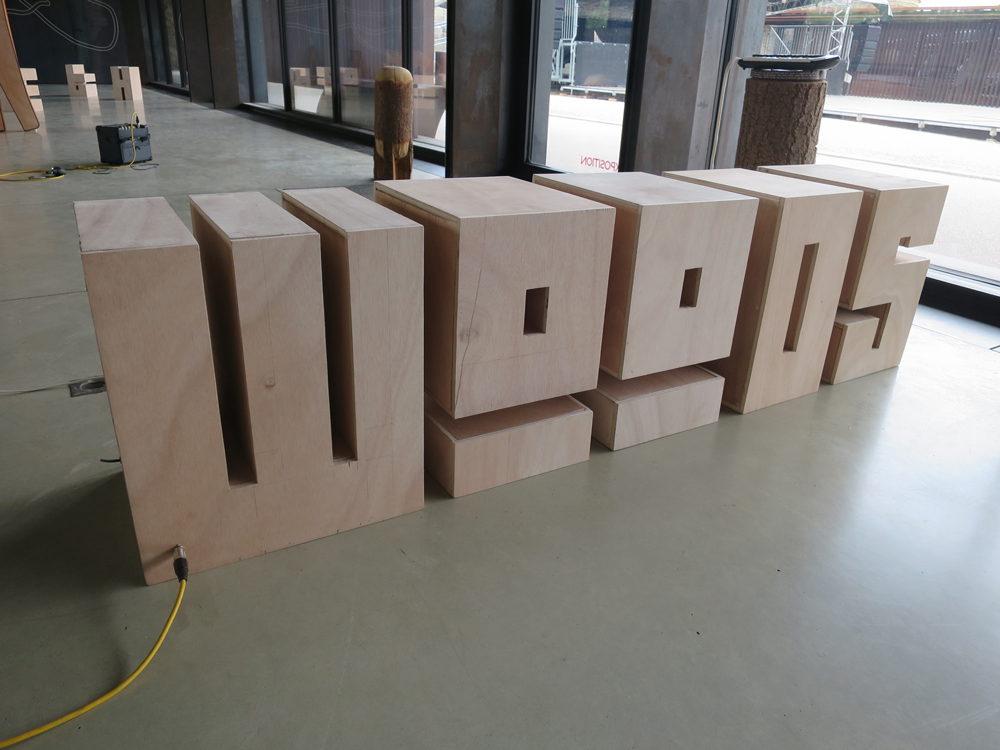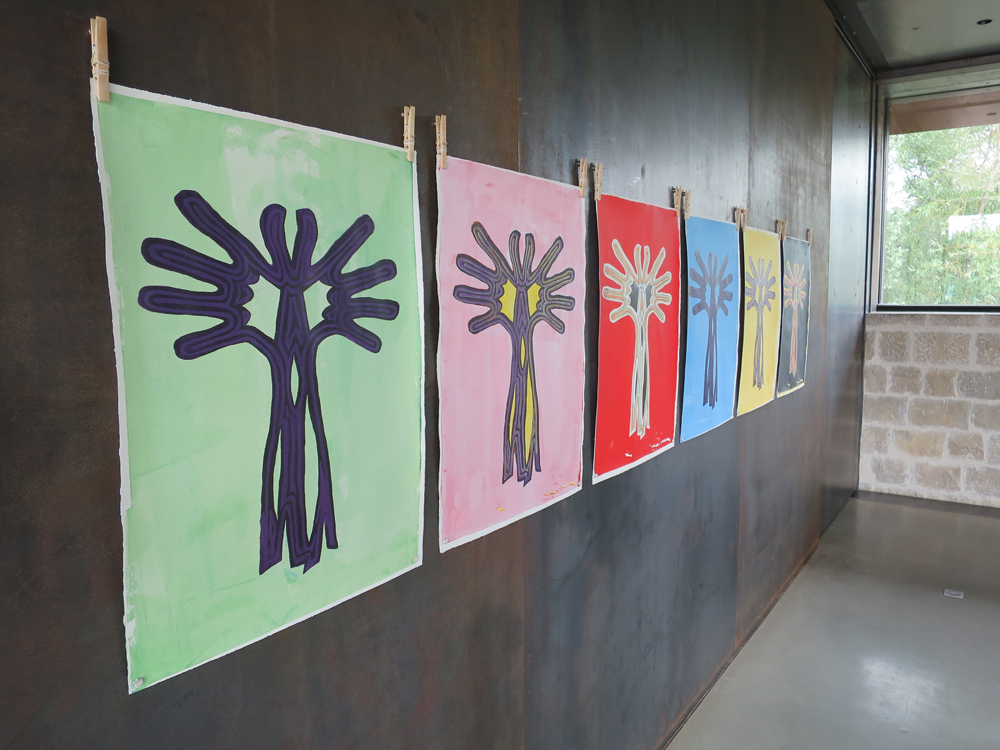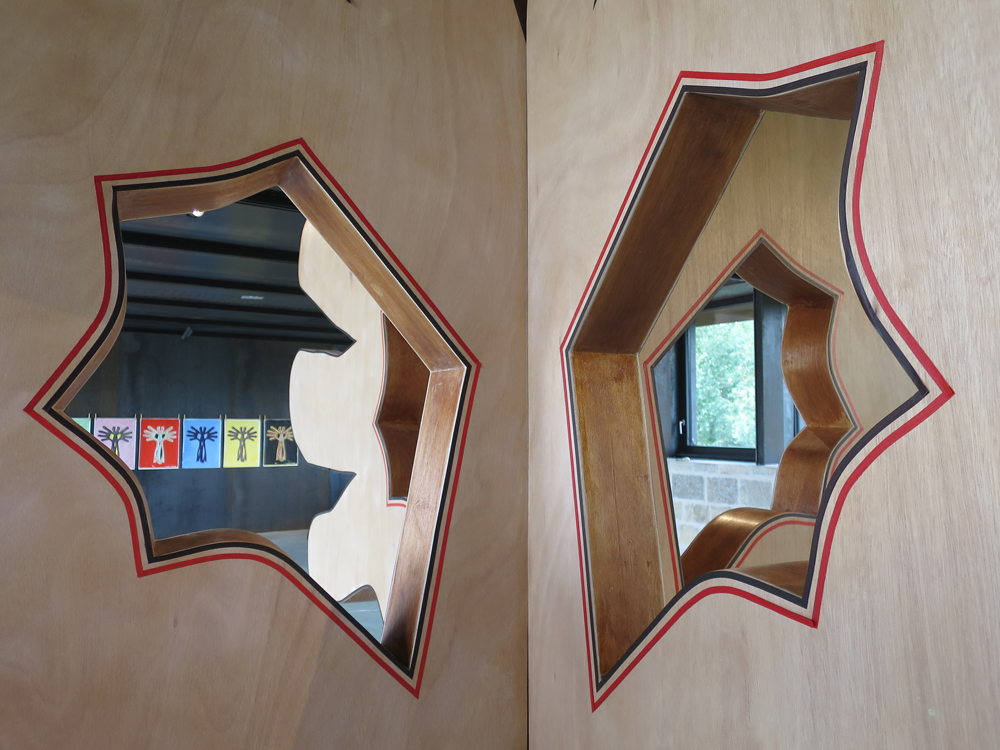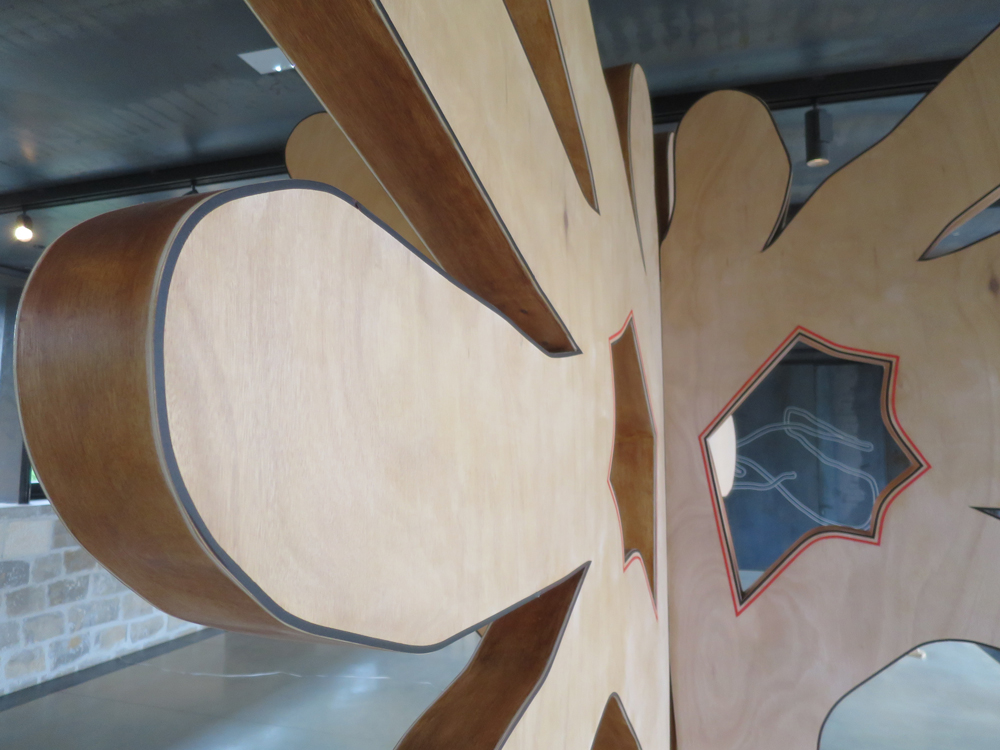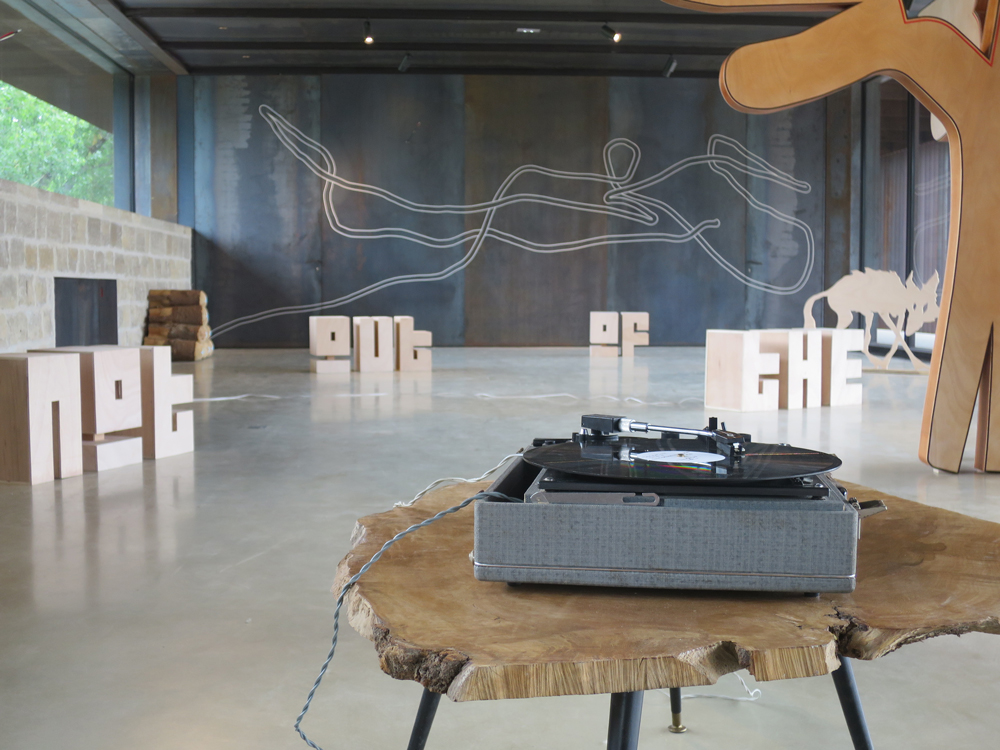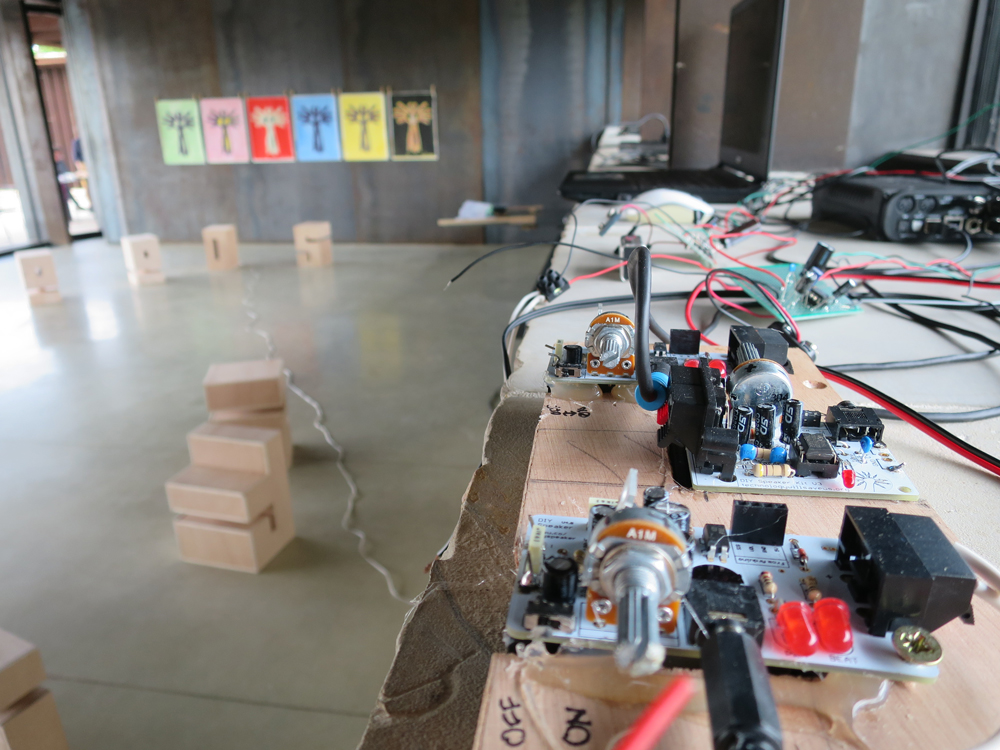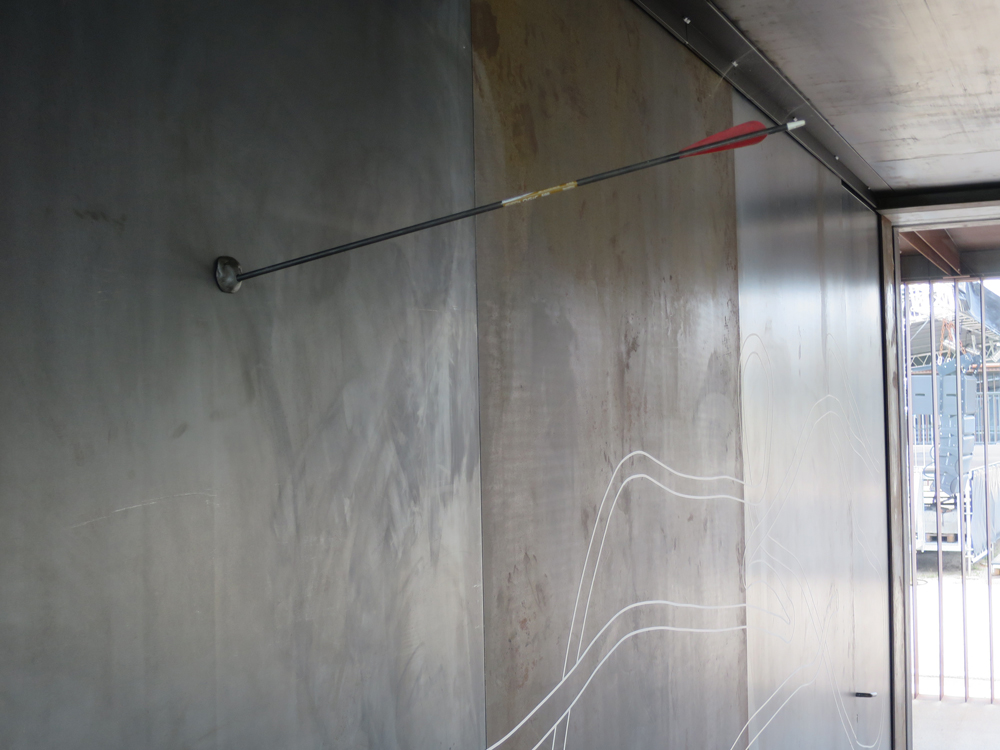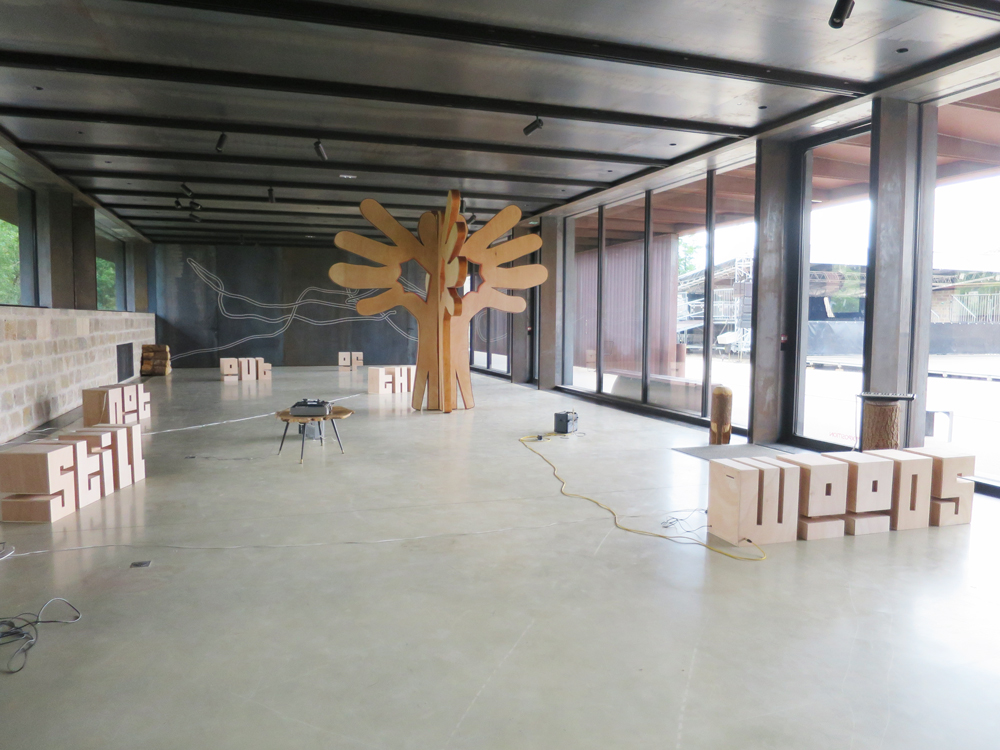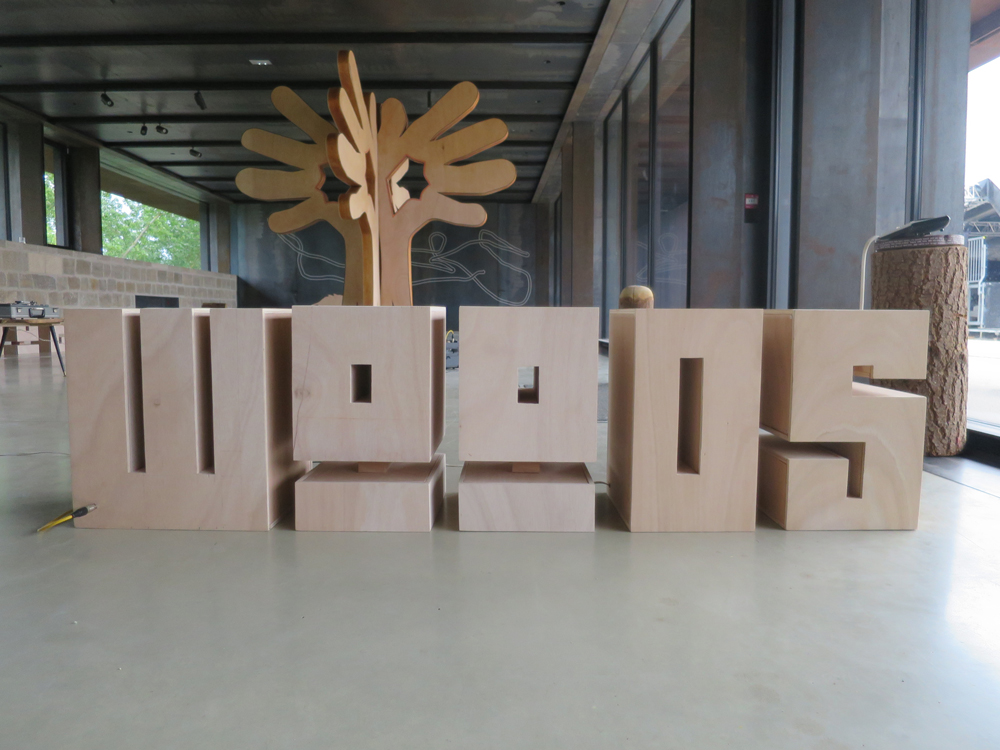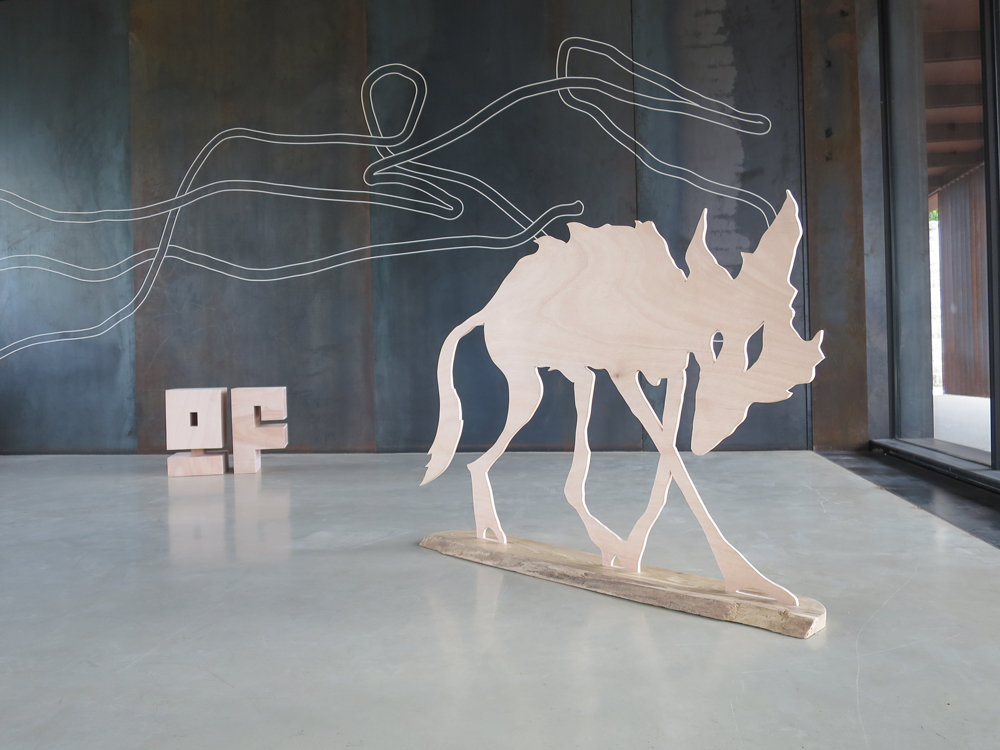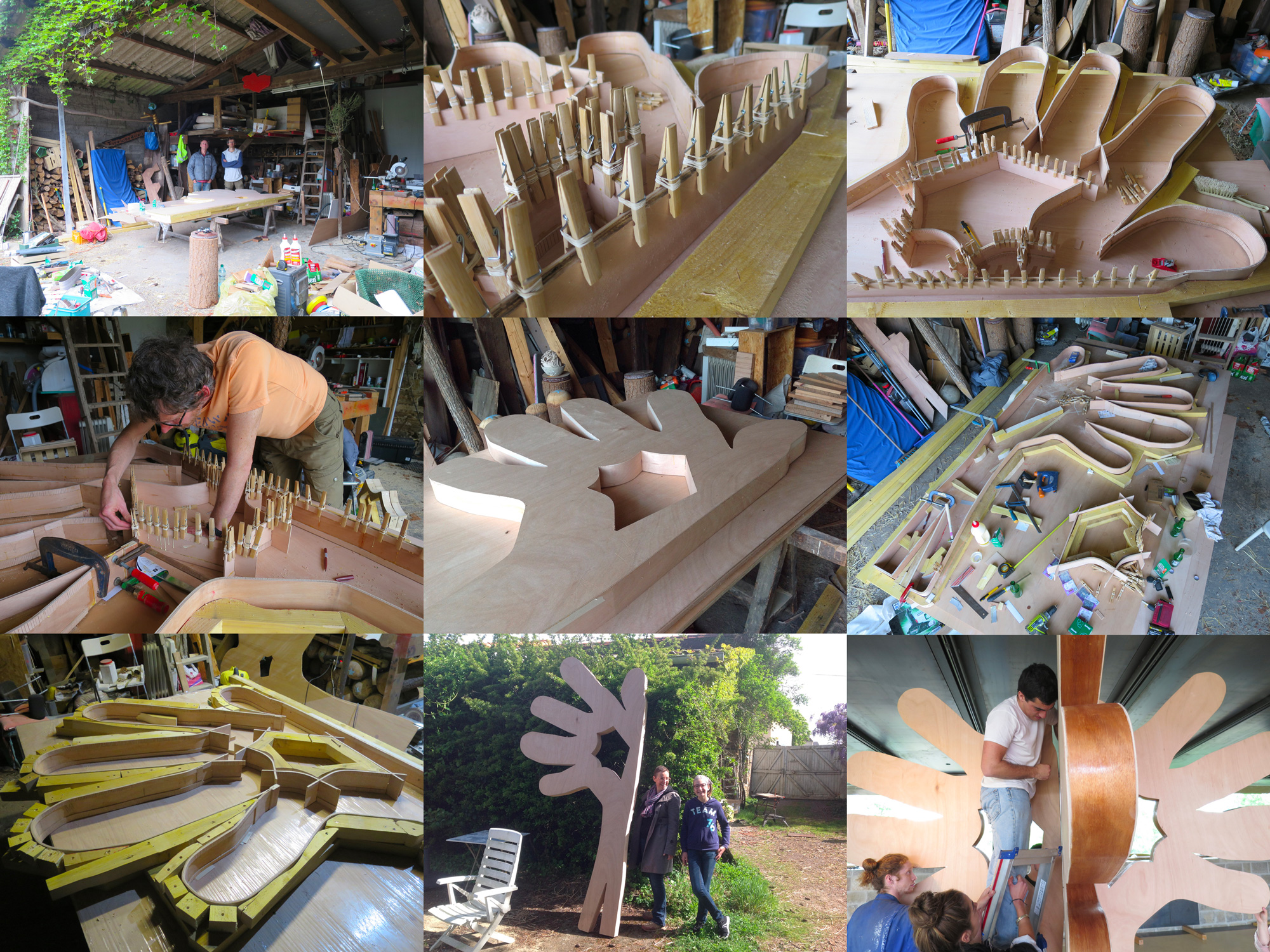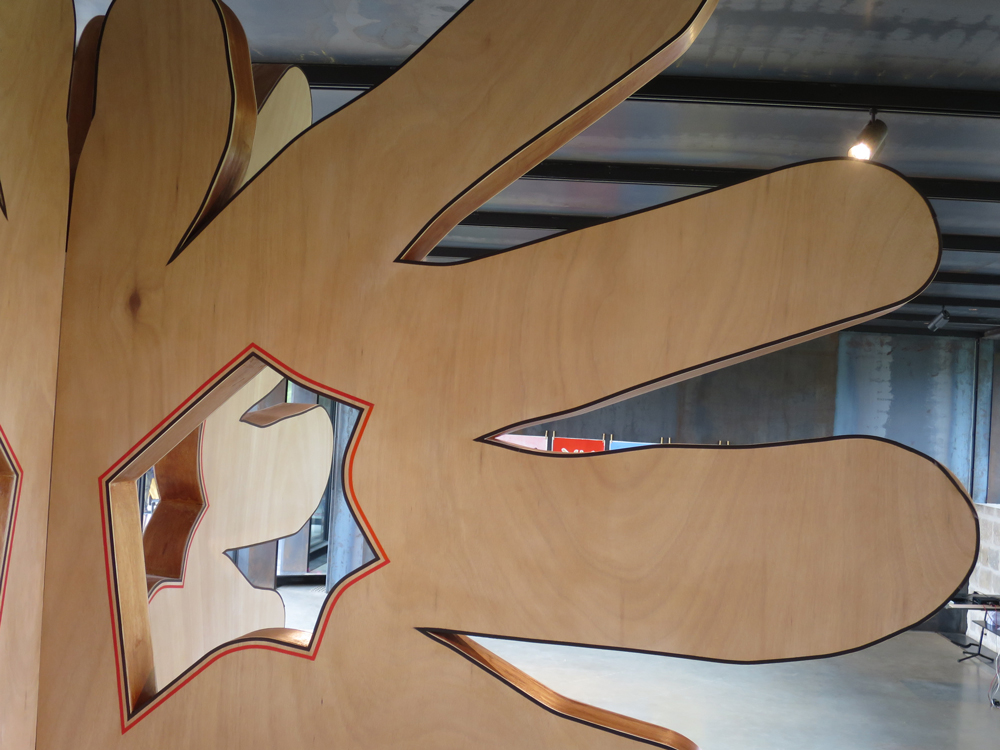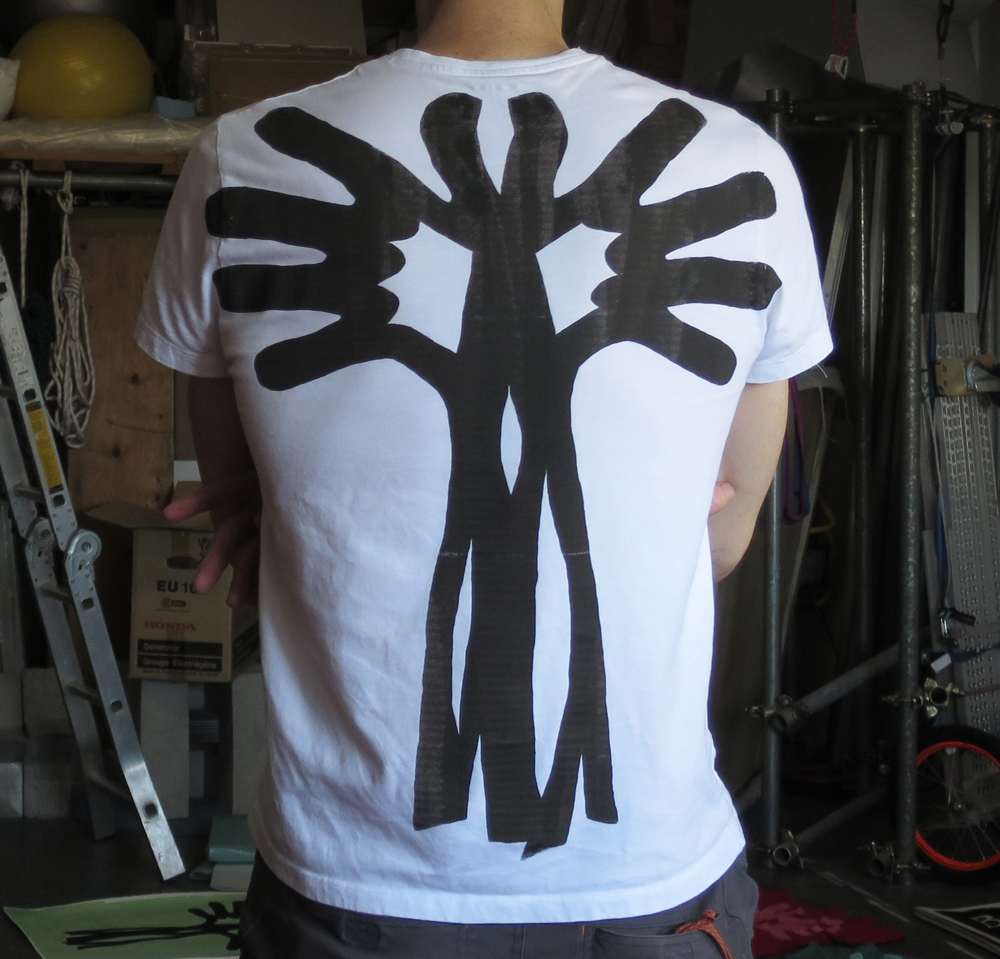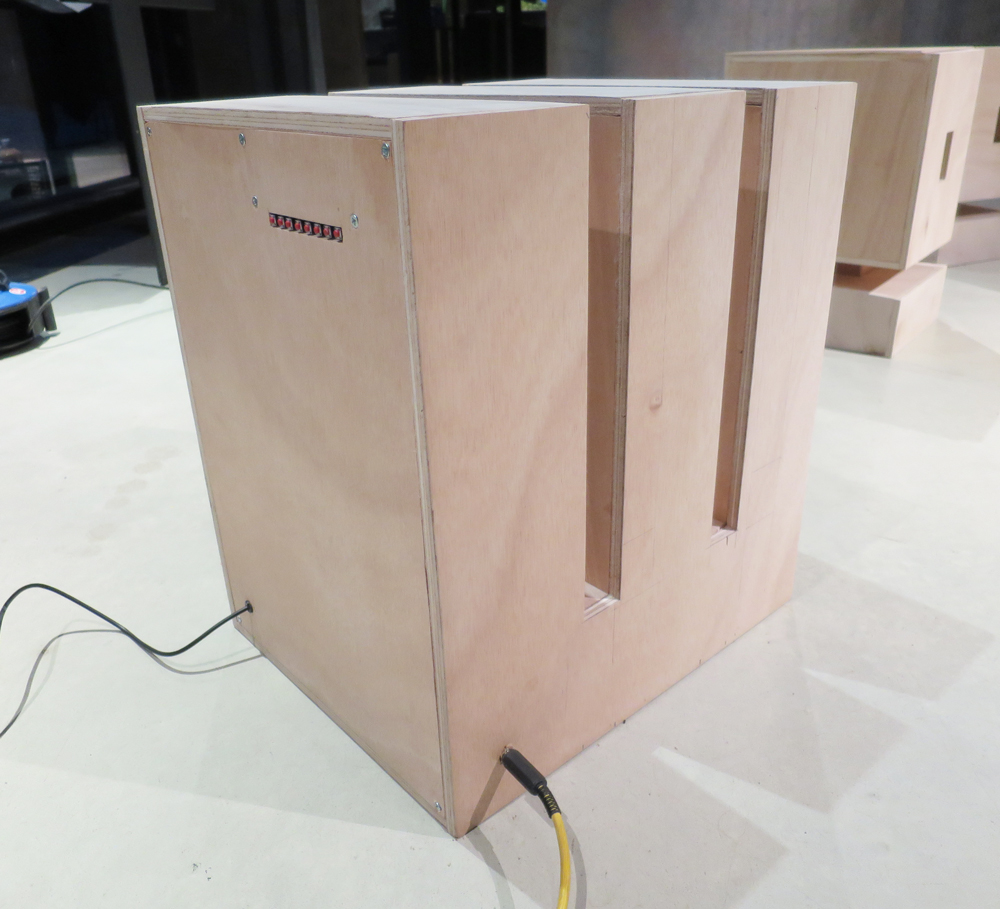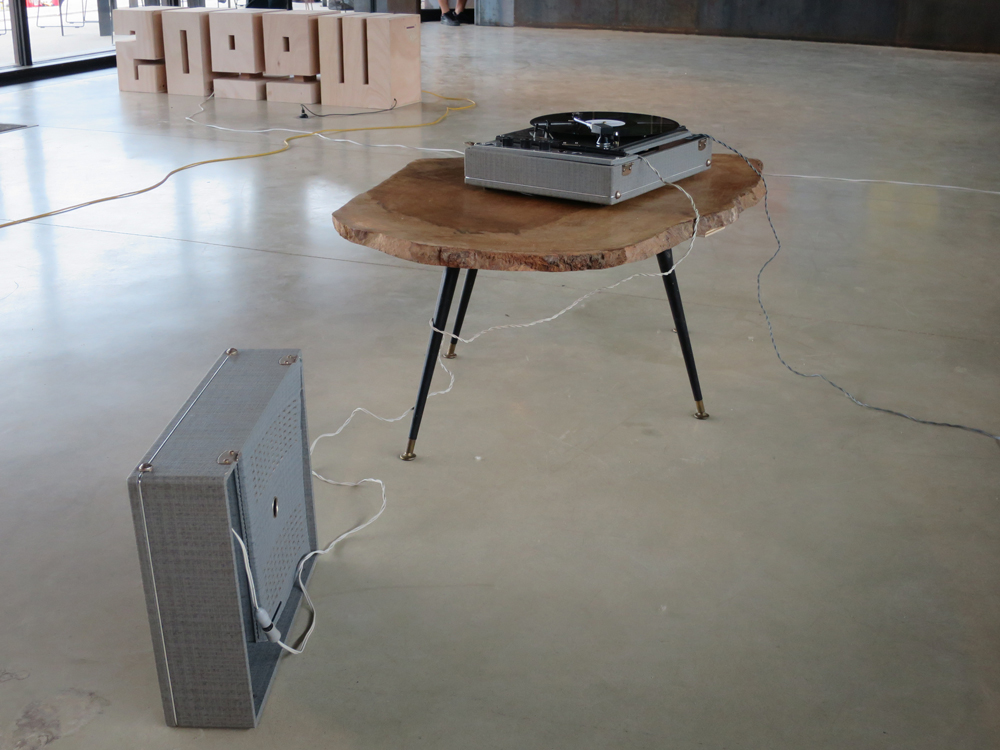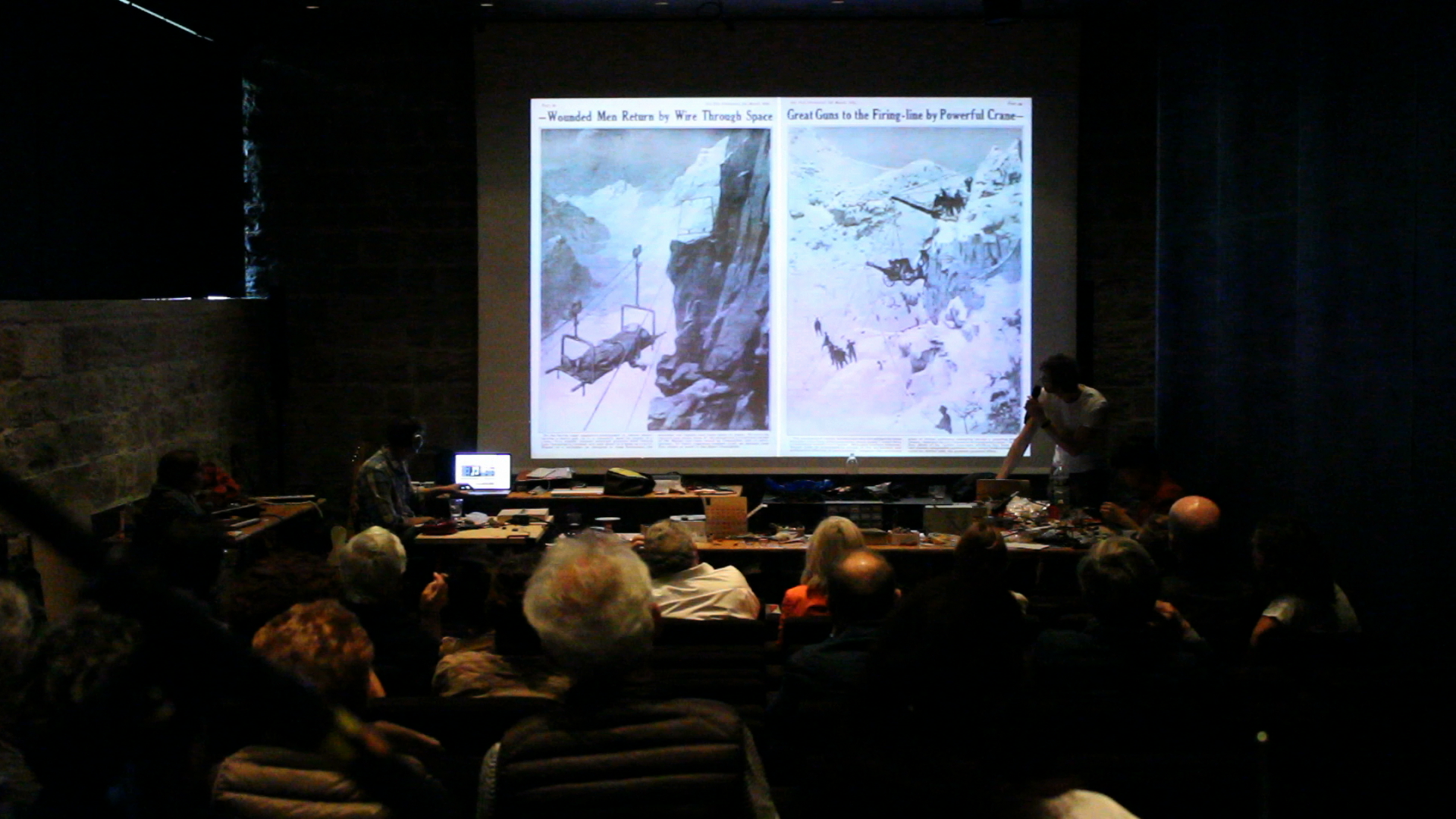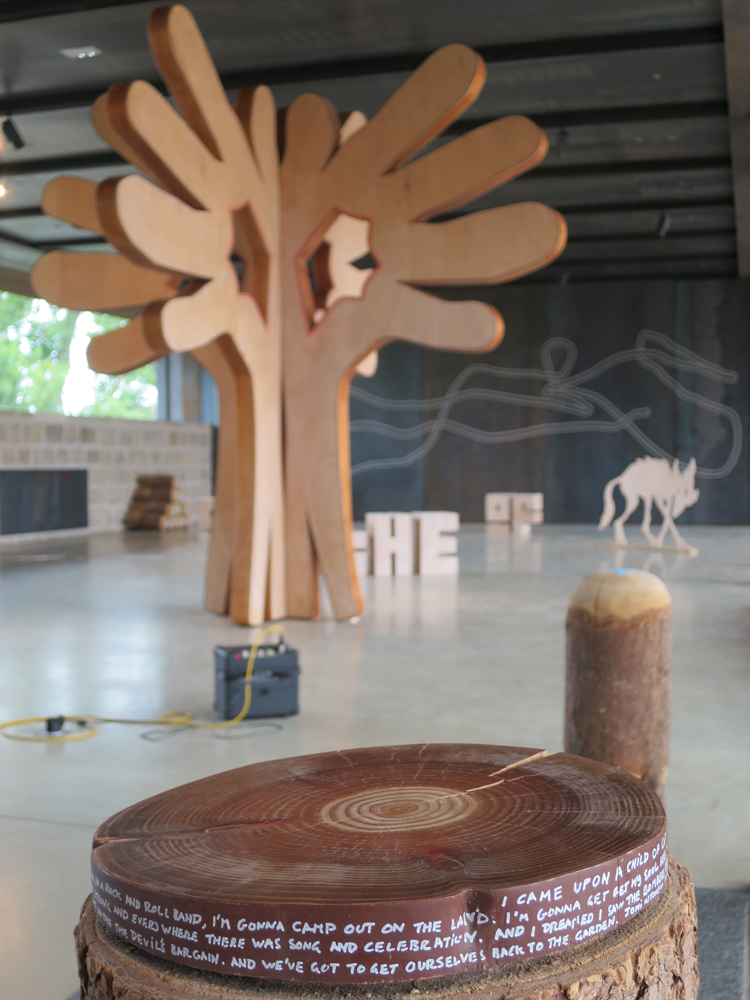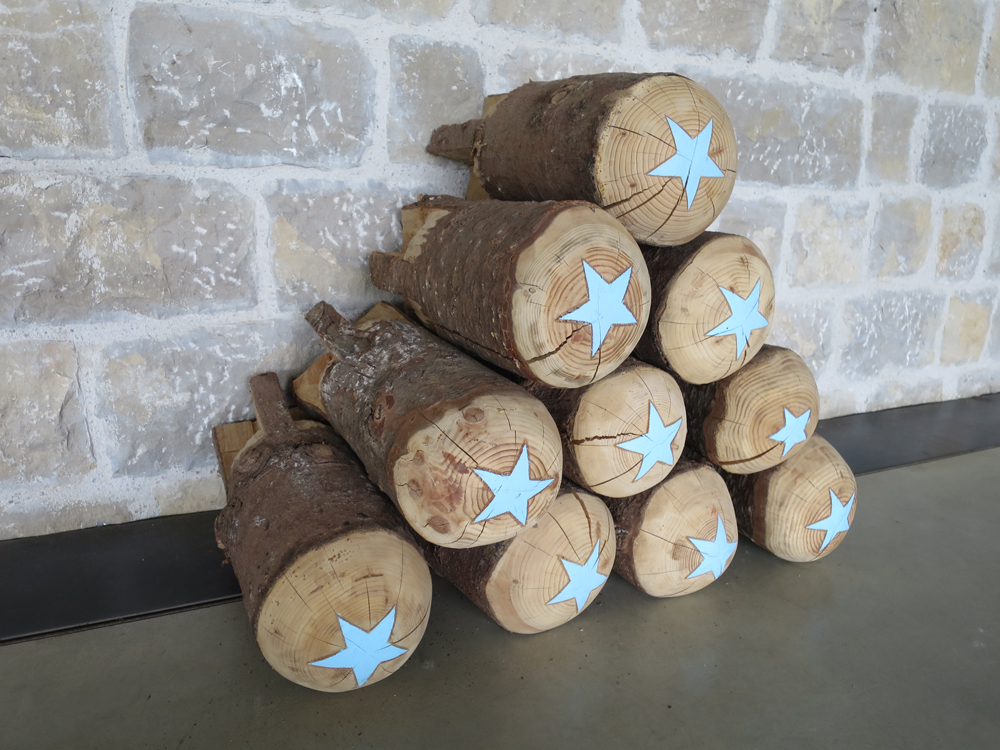The Lament of the Accolade Tree
Exhibition (sound, sculpture, performance, drawing and prints)
SHIPSIDES AND BEGGS PROJECTS
La Cuisine, France
16th June to 30 September
2018
The Accolade Tree. Plywood, varnish and painted tape. Approx 300cm x 300cm x 300cm. 2018
Originating from fake, constructed bombed-out trees in no-mans-land (WW1) which acted as reconnaissance posts, we have then mixed this motif through with Shamanism (masks), Charlie Chaplin (Shoulder Arms, 1918), David Bowie images (with his hand gesture) and other popular or folk culture regarding special trees (e.g. The Singing Ringing Tree). Another interest in trees comes from the treeline in the mountain terrain – where it broadly marks a shift in territory from habitable to non-habitable - so in a poetic sense 'we all live beneath the tree' - echoing biblical, folksong and modern idyls of the glade (e.g. 'Le Déjeuner sur l'herbe', the 'Soldier and the Lady' and 'Adam and Eve'). The popular song 'The Lonesome Pine' (1912) also acts as a fun and pertinent metaphor for this sense of isolation and yearning for love and humanity.
Trees as a motif also features heavily in the radical shift in landscape painting, as the Impressionists and their forbears turned away from the slicker motifs of the Salon to a more direct engagement with their subject and an embedded practice. In a way their choice of the tree might be understood a deference to the wisdom of the natural world and mans' place within it rather than the dominion of nature or romanticism that predominantly previous perspectives wrought. In a sense this work plays with the idea of trees observing humanity. Perhaps the trees were (or are) regarding the painters (or us) as much as the painters regarded the trees. The lament of the accolade tree (the Cherry Blossom which blooms with a spectacular flowering) is an open lament for humanity.
This sculptural work acts as the centre point for the installation. At approx. 3m high and 3m wide and deep, the Accolade Tree is designed as an acoustic device, built in 4 quarter sections using the construction materials and techniques of acoustic guitar making, so that the trees amplify any noise brought to it. e.g. via the wire or an audio vibrating device.
The Accolade Tree as a graphic motif has taken several other forms as avideo graphic, wall drawing, a large scale audio sculpture, t-shirt design and a woven badge (editioned). Here it is also developed and re-designed through silk screen prints.
More info here: http://www.danshipsides.com/DshipsidesWeb/Accolade print.html
The Lament of the Accolade Tree - poster. 57x75cm. 2018
A silk screen poster especially produced for the exhibion in an edition of 10 unique hand-made prints.
More info here: http://www.danshipsides.com/DshipsidesWeb/LATPoster.html
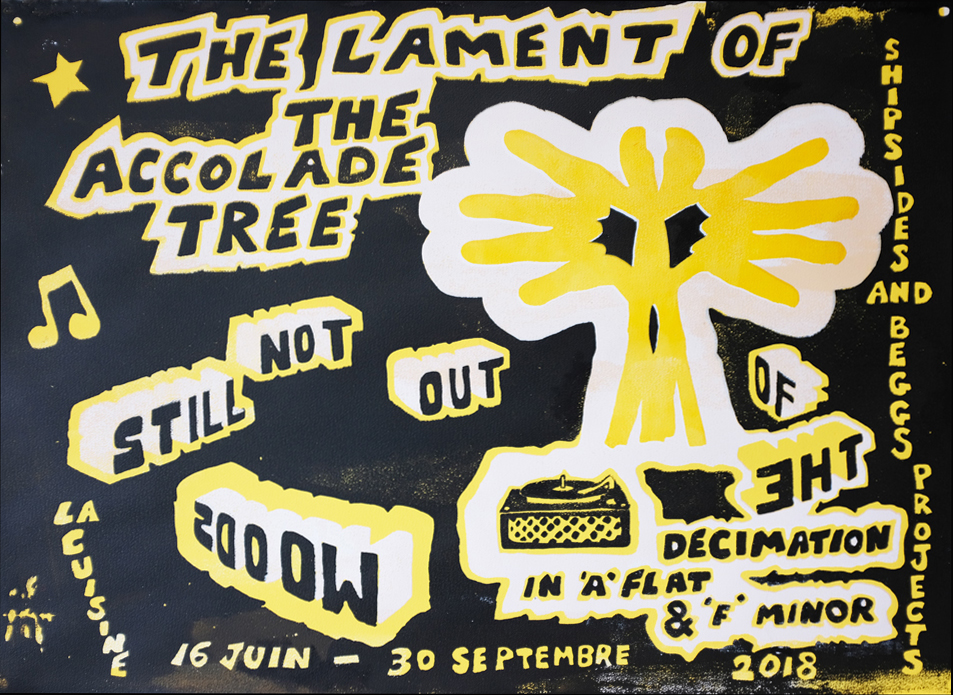
Still Not Out Of The Woods. Plywood and electronic audio. Each letter 44cm x 34cm x width dimension variable. 2018
A large scale sculptural text work - some letters of which contain various electronic audio devices.
The 'W' of WOODS for instance, containes a raspberry-pi driven sound system which enables the audience to press buttons and play, overlayering various audio tracks and loops to create their own sound track within the space (accompanying the Decimation in A-flat and F-minor record). Each letter also acts as a Cajon percussion instrument which can be sat on and played.
The Still Not Out Of The Woods phrase is a long standing Shipsides and Beggs motif which points to the ongoing state of sliding from crisis to crisis (as exemplified in Europe by WW1 to which we geo-politically can connect much to) and never resolving situations or becoming safe. The woods tended to be places of danger in previous times, however today there is a twist where we must at least ecologically see the woods as being a vital resource and component of our futures - and perhaps a place of refuge.
Decimation in A-flat and F-minor.
12inch specially commissioned vinyl record. 31mins. Edition of 4. 2018
A terrifying policy of the Italian Army in WW1 was that of Decimation, where one in ten soldiers were randomly selected and executed if any soldier in that section was thought guilty of cowardice. The audio work in the form of 12” record vinyl is played on a record player. It takes the elevation data of the 1916 Italian mountain frontier and transcodes it into musical partition, transforming that data into a topological sound piece. Configured for two pianos playing in chords A-flat and F-minor the work takes on a beautiful but haunting musical form.
Full information and documentation on Decimation in A-flat and F-minor can be found here:
http://www.danshipsides.com/DshipsidesWeb/DECIAF.html
A performance of this electronic work was developed for live recital by professional classical pianist Caroline Scotton-Goulard took place at the end of the exhibition (documentation within the link below).
An excerpt of the audio work is here:
https://vimeo.com/258876365
Full information and documentation on Decimation in A-flat and F-minor can be found here:
http://www.danshipsides.com/DshipsidesWeb/DECIAF.html
Twisted wire. Painted scotch tape wall drawing. Dimensions variable. 2018
This image is derived from a photograph of a piece of twisted iron wire which we found whilst climbing Mount Marmolada (Capanna Punta Penia, 3343m) in the Italian Dolimites. The wire was found amongst other debris exisiting from WW1. The motif echos our lyrical approach to engaging with the conflict, beauty, pathos, trauma and terrain of this geo-political context.
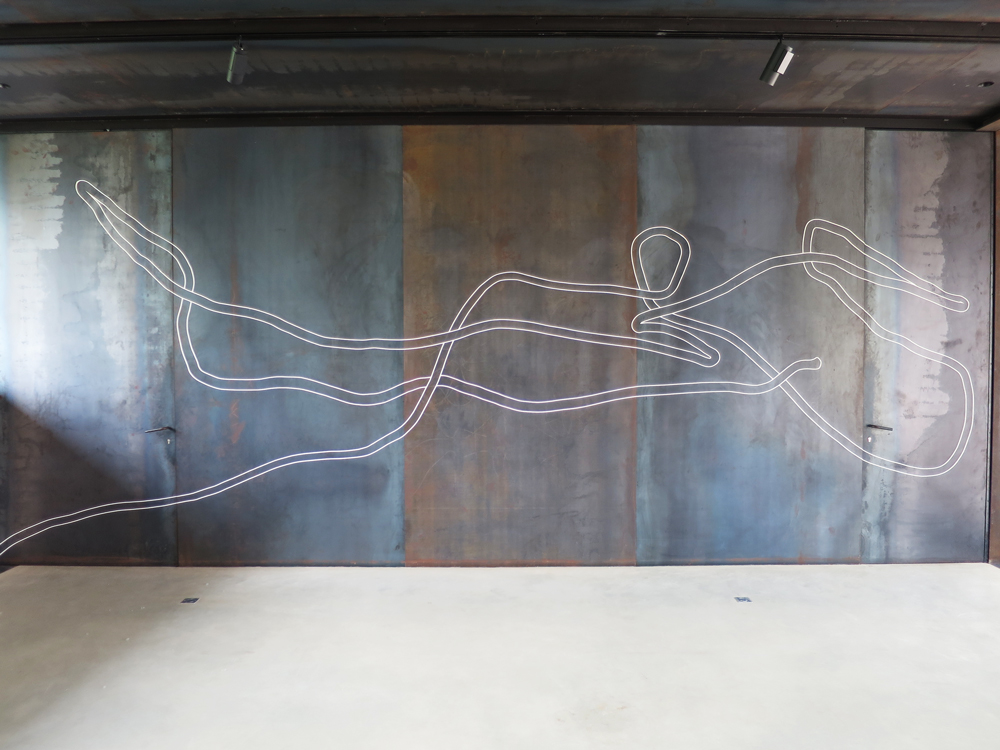
The exhibition also involved two performances of music and a 'conference' performative artist talk
The Anarchy Tree - 'conference' performative artist talk.
The talk gave an overview of the origins of some of the work, espcially looking at the wire and the tree motifs. It then gave an exploration of anarchist geography and practice through the experimental connection of our work with that of Camille Pissaro and Paul Cezanne. The ground and sources covered included Chaplin's 1918 Shoulder Arms film, David Bowie, Pyotr Kropotkin, Elisee Reclus, WW1 fake observation trees, the concept of the tree-line and elevation, HG Wells' war correspondance and Camille Pissarro's ideas about life, nature, beauty and art that is anarchist. It also featured two songs including the first attempt at a blues version of Frontier Soldier and an adapted cover of Laurel and Hardy's Lonesome Pine.
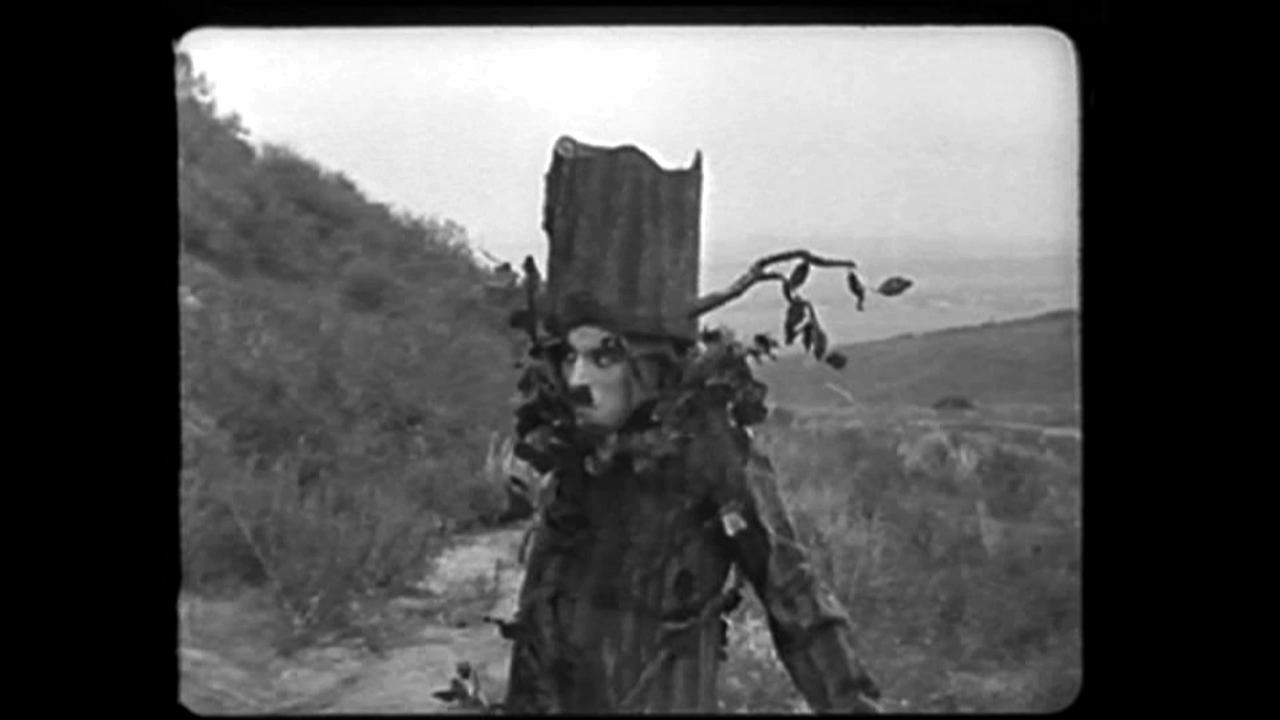
Still from Shoulder Arms, 1918, Charlie Chaplin
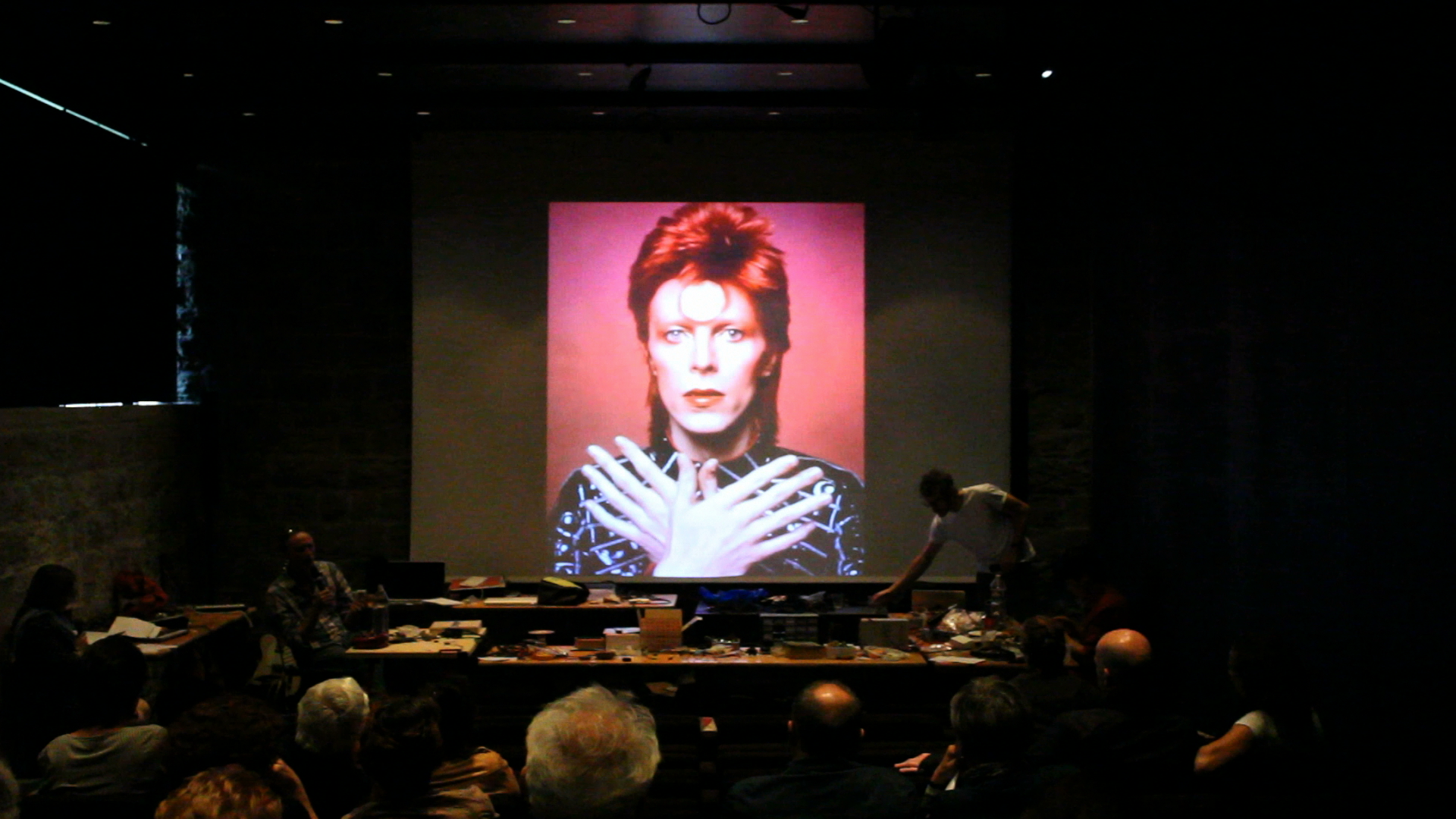
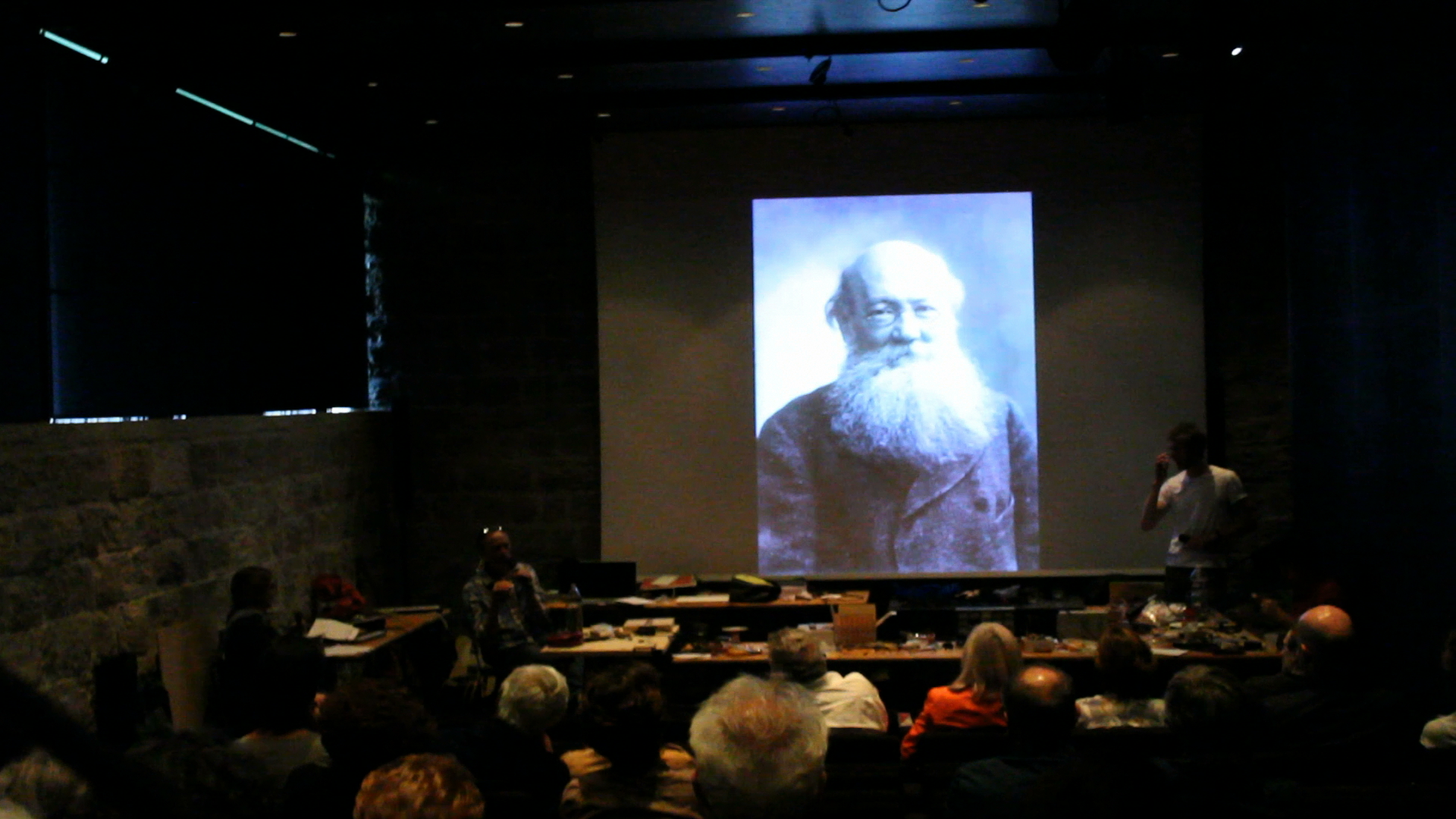
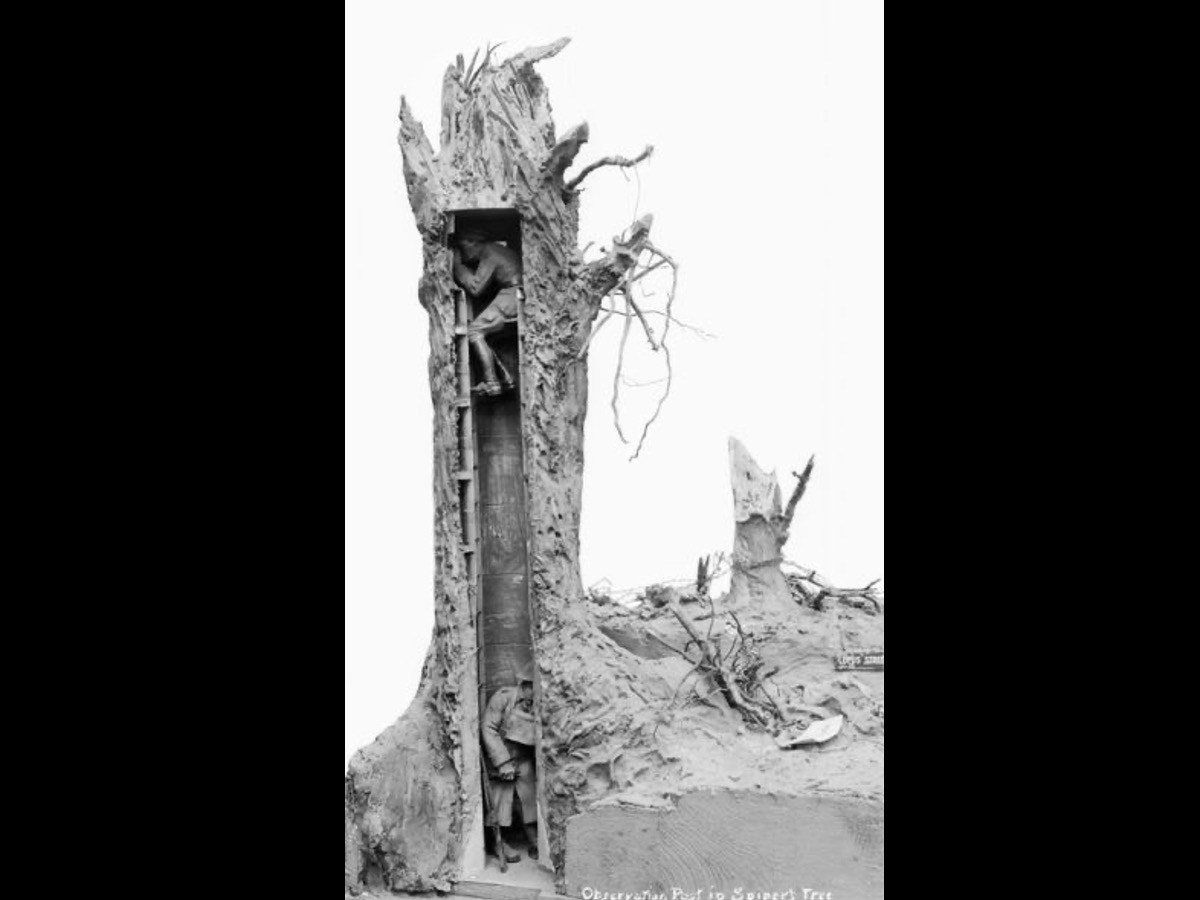
THE ANARCHY TREE for further information click here.
The documentation video is presented here:
https://vimeo.com/359539573
Additional works:
A number of smaller works such as carved bombs, a record player trunk, arrows and a wolf are all ideas from previous projects which were relevant to redevelop within this exhibition.
The wolf appeared in a project in Nantes in a work called Lumiere de Loup (Nottanum, 2017) where it acted as a double edged symbol of threat, fear and predjudice (a mythology in story-telling and amplified in modern times through the screen, where wolves act as a threat to society - the other, the foreigner, the monster) but also in reality as a beautiful and an essential component of a fragile ecology. The standing sculptural wolf made here is new and produced in plywood with a wooden base.
The wooden bombs have appeared in several exhibitions. Reflecting a curious fact that in WW2 wooden bombs supplemented actual bombs and were dropped on cities in daylight raids to act as a visual display of strength - fooling the enemy into thinking the munition stocks were healthier than they actually were. Upon impact the wooden bombs would have disintegrated - but could cause significant damage in themselves. This work has also played with the term Woodstock as a connection to the counter-culture festival and the 1970 song by Joni Mitchell. This song also features on a text on the wooden record-player tree-trunk, where the tree-rings act as pataphor for the grooves of a record - as if embedding the knowledge or wisdom of the tree-rings into the knowledge encapsulated in such a song "we are stardust, we are golden - we are billion year old carbon" (the Crosby, Stills, Nash and Young version).
The arrow has also appeared in previous shows in an inventive sense acting as a pivot in some works and a gesture of futility - here where the arrow is pitted against the metal building - against an armour it seems not suited to penetrate or defeat. The arrow has also acted as a symbol of the Standing Rock protests.
